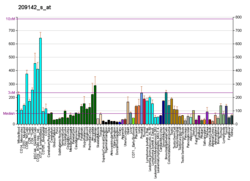UBE2G1
Ubiquitin-conjugating enzyme E2 G1 is a protein that in humans is encoded by the UBE2G1 gene.[5][6]
The modification of proteins with ubiquitin is an important cellular mechanism for targeting abnormal or short-lived proteins for degradation. Ubiquitination involves at least three classes of enzymes: ubiquitin-activating enzymes, or E1s, ubiquitin-conjugating enzymes, or E2s, and ubiquitin-protein ligases, or E3s. This gene encodes a member of the E2 ubiquitin-conjugating enzyme family and catalyzes the covalent attachment of ubiquitin to other proteins. The protein may be involved in degradation of muscle-specific proteins.[6]
References
- 1 2 3 GRCh38: Ensembl release 89: ENSG00000132388 - Ensembl, May 2017
- 1 2 3 GRCm38: Ensembl release 89: ENSMUSG00000020794 - Ensembl, May 2017
- ↑ "Human PubMed Reference:".
- ↑ "Mouse PubMed Reference:".
- ↑ Watanabe TK, Kawai A, Fujiwara T, Maekawa H, Hirai Y, Nakamura Y, Takahashi E (Dec 1996). "Molecular cloning of UBE2G, encoding a human skeletal muscle-specific ubiquitin-conjugating enzyme homologous to UBC7 of C. elegans". Cytogenet Cell Genet. 74 (1–2): 146–8. doi:10.1159/000134403. PMID 8893823.
- 1 2 "Entrez Gene: UBE2G1 ubiquitin-conjugating enzyme E2G 1 (UBC7 homolog, yeast)".
Further reading
- Chen P, Johnson P, Sommer T, et al. (1993). "Multiple ubiquitin-conjugating enzymes participate in the in vivo degradation of the yeast MAT alpha 2 repressor". Cell. 74 (2): 357–69. doi:10.1016/0092-8674(93)90426-Q. PMID 8393731.
- Katsanis N, Fisher EM (1998). "Identification, expression, and chromosomal localization of ubiquitin conjugating enzyme 7 (UBE2G2), a human homologue of the Saccharomyces cerevisiae ubc7 gene". Genomics. 51 (1): 128–31. doi:10.1006/geno.1998.5263. PMID 9693041.
- Moynihan TP, Ardley HC, Nuber U, et al. (1999). "The ubiquitin-conjugating enzymes UbcH7 and UbcH8 interact with RING finger/IBR motif-containing domains of HHARI and H7-AP1". J. Biol. Chem. 274 (43): 30963–8. doi:10.1074/jbc.274.43.30963. PMID 10521492.
- Huang L, Kinnucan E, Wang G, et al. (1999). "Structure of an E6AP-UbcH7 complex: insights into ubiquitination by the E2-E3 enzyme cascade". Science. 286 (5443): 1321–6. doi:10.1126/science.286.5443.1321. PMID 10558980.
- Joazeiro CA, Hunter T (2000). "Biochemistry. Ubiquitination--more than two to tango". Science. 289 (5487): 2061–2. doi:10.1126/science.289.5487.2061. PMID 11032556.
- Tiwari S, Weissman AM (2001). "Endoplasmic reticulum (ER)-associated degradation of T cell receptor subunits. Involvement of ER-associated ubiquitin-conjugating enzymes (E2s)". J. Biol. Chem. 276 (19): 16193–200. doi:10.1074/jbc.M007640200. PMID 11278356.
- Imai Y, Soda M, Inoue H, et al. (2001). "An unfolded putative transmembrane polypeptide, which can lead to endoplasmic reticulum stress, is a substrate of Parkin". Cell. 105 (7): 891–902. doi:10.1016/S0092-8674(01)00407-X. PMID 11439185.
- Strausberg RL, Feingold EA, Grouse LH, et al. (2003). "Generation and initial analysis of more than 15,000 full-length human and mouse cDNA sequences". Proc. Natl. Acad. Sci. U.S.A. 99 (26): 16899–903. doi:10.1073/pnas.242603899. PMC 139241. PMID 12477932.
- Gevaert K, Goethals M, Martens L, et al. (2004). "Exploring proteomes and analyzing protein processing by mass spectrometric identification of sorted N-terminal peptides". Nat. Biotechnol. 21 (5): 566–9. doi:10.1038/nbt810. PMID 12665801.
- Kim BW, Zavacki AM, Curcio-Morelli C, et al. (2004). "Endoplasmic reticulum-associated degradation of the human type 2 iodothyronine deiodinase (D2) is mediated via an association between mammalian UBC7 and the carboxyl region of D2". Mol. Endocrinol. 17 (12): 2603–12. doi:10.1210/me.2003-0082. PMID 12933904.
- Gerhard DS, Wagner L, Feingold EA, et al. (2004). "The status, quality, and expansion of the NIH full-length cDNA project: the Mammalian Gene Collection (MGC)". Genome Res. 14 (10B): 2121–7. doi:10.1101/gr.2596504. PMC 528928. PMID 15489334.
- Rual JF, Venkatesan K, Hao T, et al. (2005). "Towards a proteome-scale map of the human protein-protein interaction network". Nature. 437 (7062): 1173–8. doi:10.1038/nature04209. PMID 16189514.
This article is issued from
Wikipedia.
The text is licensed under Creative Commons - Attribution - Sharealike.
Additional terms may apply for the media files.







